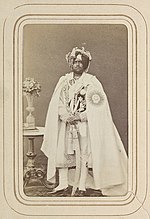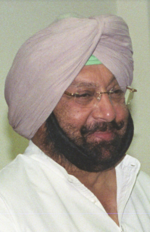| Maharaja of Patiala | |
|---|---|
 | |
| Details | |
| Style | His Highness |
| First monarch | Ala Singh |
| Last monarch | Yadavindra Singh |
| Formation | March 29, 1761 |
| Abolition | August 15, 1947 |
| Residence | Qila Mubarak, Patiala |
| Pretender(s) | Captain Amarinder Singh |


The Maharaja of Patiala was the title of a Maharaja in India and the ruler of the princely state of Patiala, a state in British India. The first Maharaja of Patiala was Baba Ala Singh (1695–1765). [2]
Maharaja Yadavindra Singh became the maharaja on 23 March 1938. He was the last independent maharaja, agreeing to the accession of Patiala State into the newly independent Union of India in 1947. On 5 May 1948, he became Rajpramukh of the new Indian state of Patiala and East Punjab States Union. The Royal Patiala Dynasty has had multiple notable members post-independence in politics, army and other matters. [3]
Early proposals of a Sikh nation of ‘Sikhistan’ led by Maharaja of Patiala were published by Dr VS Bhatti for a “Khalistan led by the Maharaja of Patiala with the aid of a cabinet consisting of representative federating units. [4] [5] [6] [7]”. These would consist of the central districts of Punjab province then directly administered by the British, including Ludhiana, Jalandhar, Ambala, Ferozpur, Amritsar and Lahore; the 'princely states' of the Cis-Sutlej, including Patiala, Nabha, Faridkot and Malerkolta; and the 'Shimla Group' of states. After partition of India in 1947, The Liberator, a Sikh publication advocated for Khalistan which would include East Punjab merged with PEPSU led by Maharaja of Patiala as it’s Monarch. [8]
Origin
The Maharajas of Patiala were Jats of Sidhu gotra. [9] [10]
List
| No. | Name
(Birth–Death) |
Portrait | Reign | Enthronement | Ref. |
|---|---|---|---|---|---|
| Sardars | |||||
| 1 | Baba
Ala Singh (1691 or 1695 – 1765) |

|
1709 – 1765 | ? | [11] [12] |
| Maharajas | |||||
| 2 | Maharaja Amar Singh (7 June 1748 – February 1781) |

|
1765 – 1781 | ? | [11] [12] |
| 3 | Maharaja Sahib Singh (18 August 1773 – 26 March 1813) |

|
1781 – 1813 | ? | [11] [12] |
| 4 | Maharaja Karam Singh (12 October 1797 – 23 December 1845) |

|
1813 – 1845 | 30 June 1813 | [11] [12] |
| 5 | Maharaja
Narinder Singh (26 October 1824 – 13 November 1862) |

|
1845 – 1862 | 18 January 1846 | [11] |
| 6 | Maharaja
Mahendra Singh (16 September 1852 – 13 or 14 April 1876) |

|
1862 – 1876 | 29 January 1863 | [11] |
| 7 | Maharaja
Rajinder Singh (25 May 1872 – 8 November 1900) |

|
1876 – 1900 | 6 January 1877 | [11] |
| 8 | Maharaja
Bhupinder Singh (12 October 1891 – 1938) |

|
1900 – 1938 | ? | [11] |
| 9 | Maharaja
Yadavindra Singh (7 January 1913 – 17 June 1974) |

|
1938 – 1974 | ? | [11] |
| Titular | |||||
| 10 | Maharaja
Amarinder Singh (born 11 March 1942) |

|
1974 – ? | ? | [13] [14] |
| 11 | Yuvraj Raninder Singh | — | — | — | |
See also
- Patiala House Courts Complex housed in the former palace of the Maharaja
Notes
- ^ Delhi School (c. 1817). "Nine courtiers and servants of the Raja Patiala". Archived from the original on 30 December 2018. Retrieved 27 June 2013.
- ^ Singh, Kirpal (c. 1954). Life of Maharaja Ala Singh of Patiala and His Times.
- ^ "Kings of Patiala, Chronolgy of Patiala, Kings Rule in Patiala". www.patialaonline.in. Retrieved 5 December 2023.
- ^ Shani, Giorgio (2007). Sikh Nationalism and Identity in a Global Age. doi: 10.4324/9780203937211. ISBN 9781134101894.
- ^ Shani, Giorgio (6 December 2007). Sikh Nationalism and Identity in a Global Age. Routledge. ISBN 978-1-134-10188-7.
- ^ Archives, The National. "The National Archives - Homepage". The National Archives. Retrieved 14 October 2022.
- ^ Pathak, Ritika (12 December 2020). "Khalistan movement: Origin and the two different narratives". Newshour Press. Retrieved 14 October 2022.
- ^ Singh, Amar. "LET PATIALA LEAD THE PANTH TO GLORY". National Achieves UK.
- ^ The Leisure Hour. W. Stevens, printer. 1876.
- ^ Philaurī, Sharadhā Rāma (1888). History of the Sikhs: Or, Translation of the Sikkhan de Raj Di Vikhia, as Laid Down for the Examination in Panjabi. Together with a Short Gurmukhi Grammar, and an Appendix Containing Some Useful Technical Words, in Roman Character. Translated and Edited by Henry Court. Printed at the "Civil and Military Gazette" Press.
- ^ a b c d e f g h i Singh, Bhagat (1993). "Chapter 14 - The Phulkian Misl". A History of the Sikh Misals. Publication Bureau, Punjabi University. pp. 188–215.
- ^ a b c d ANNE-COLOMBE “SAT KAUR” LAUNOIS. “Essence Du Pouvoir de Pattâlâ: Les Estrades Royales Du Qila Mubârak.” Arts Asiatiques, vol. 62, 2007, pp. 46–62. JSTOR, JSTOR 43486550. Accessed 15 Feb. 2023.
- ^ Quint, The (10 March 2017). "Punjab Live: Modi Congratulates Amarinder, Wishes Him Happy B'Day". The Quint. Retrieved 11 March 2017.
- ^ "Who is Capt Amarinder Singh? Everything you need to know". The Indian Express. Express Web Desk. 16 March 2017. Retrieved 16 March 2017.